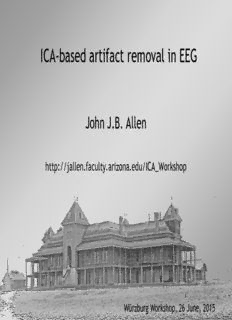
ICA-based artifact removal in EEG PDF
Preview ICA-based artifact removal in EEG
ICA-based artifact removal in EEG John J.B. Allen http://jallen.faculty.arizona.edu/ICA_Workshop Würzburg Workshop, 26 June, 2015 ICA-based artifact removal in EEG John J.B. Allen http://jallen.faculty.arizona.edu/ICA_Workshop Würzburg Workshop, 26 June, 2015 “Clinical” vs Actuarial Approaches Dawes, R.M., Faust, D., & Meehl, P.E.(1989). Science, 243, 1668-1674. “Clinical” vs Actuarial Approaches Human raters Good source of possible algorithms Lousy at reliably implementing them Inter-rater Intra-rater Actuarial methods Always arrive at the same conclusion Weight variables according to actual predictive power Dawes, R.M., Faust, D., & Meehl, P.E.(1989). Science, 243, 1668-1674. Algorithmic EEG Artifact Approaches Amplitude criteria Too sudden: 100uV between samples Activity criteria Too big: 250uV/2sec epoch Too small: <0.5 uV range across 100ms Regression-based EOG correction Can we make ICA-based correction algorithmic? What is ICA? ICA is a "blind source separation" technique. ICA separates sources of activity that are mixed together at recording electrodes. What is ICA? For EEG data Channel data (X) can be thought of as a weighted (W) combination of independent component activations (Wx), each of which has a scalp projection (W-1). You can think of ICs as putative sources of the scalp-recorded EEG.
Description: